Page 1 of 17 pages
SMPTE 272M-2004
Revision of
ANSI/SMPTE 272M-1994
SMPTE STANDARD
for Television
Formatting AES Audio and
Auxiliary Data into Digital
Video Ancillary Data Space
1 Scope
1.1 This standard defines the mapping of AES digital audio data, AES auxiliary data, and associated control
information into the ancillary data space of serial digital video conforming to ANSI/SMPTE 259M or SMPTE
344M. The audio data and auxiliary data are derived from AES3, hereafter referred to as AES audio. The AES
audio data may contain linear PCM audio or non-PCM data formatted according to SMPTE 337M.
1.2 Audio sampled at 48 kHz and clock locked (synchronous) to video is the preferred implementation for
intrastudio applications. As an option, this standard supports AES audio at synchronous or asynchronous
sampling rates from 32 kHz to 48 kHz.
1.3 The minimum, or default, operation of this standard supports 20 bits of audio data as defined in clause
3.5. As an option, this standard supports 24-bit audio or four bits of AES auxiliary data as defined in clause 3.10.
1.4 This standard provides a minimum of two audio channels and a maximum of 16 audio channels based on
available ancillary data space in a given format (four channels maximum for composite digital). Audio
channels are transmitted in pairs combined, where appropriate, into groups of four. Each group is identified by
a unique ancillary data ID.
1.5 Several modes of operation are defined and letter suffixes are applied to the nomenclature for this
standard to facilitate convenient identification of interoperation between equipment with various capabilities.
The default form of operation is 48-kHz synchronous audio sampling carrying 20 bits of AES audio data and
defined in a manner to ensure reception by all equipment conforming to this standard.
2 Normative references
The following standards contain provisions which, through reference in this text, constitute provisions of this
standard. At the time of publication, the editions indicated were valid. All standards are subject to revision,
and parties to agreements based on this standard are encouraged to investigate the possibility of applying the
most recent edition of the standards indicated below.
AES3-2003, AES standard for Digital Audio — Digital Input-Output Interfacing — Serial Transmission Format
for Two-Channel Linearly Represented Digital Audio Data (AES3)
ANSI/SMPTE 259M-1997, Television — 10-Bit 4:2:2 Component and 4fsc NTSC Composite Digital Signals —
Serial Digital Interface
SMPTE 291M-1998, Television — Ancillary Data Packet and Space Formatting
Copyright © 2004 by THE SOCIETY OF
MOTION PICTURE AND TELEVISION ENGINEERS
595 W. Hartsdale Ave., White Plains, NY 10607
(914) 761-1100
Approved
April 7, 2004
�
SMPTE 272M-2004
SMPTE 337M-2000, Television — Format for Non-PCM Audio and Data in an AES3 Serial Digital Audio
Interface
SMPTE 344M-2000, Television — 540 Mb/s Serial Digital Interface
SMPTE RP 165-1994, Error Detection Checkwords and Status Flags for Use in Bit-Serial Digital Interfaces for
Television
SMPTE RP 168-2002, Definition of Vertical Interval Switching Point for Synchronous Video Switching
3 Definition of terms
3.1 AES audio: All the VUCP data, audio data and auxiliary data, associated with one AES digital stream as
defined in AES3.
3.2 AES frame: Two AES subframes, one with audio data for channel 1 followed by one with audio data for
channel 2.
3.3 AES subframe: All data associated with one AES audio sample for one channel in a channel pair.
3.4 audio control packet: An ancillary data packet occurring once a field in an interlaced system (once a
frame in a progressive system) and containing data used in the operation of optional features of this standard.
3.5 audio data: 23 bits: 20 bits of AES audio associated with one audio sample, not including AES auxiliary
data, plus the following 3 bits: sample validity (V bit), channel status (C bit), and user data (U bit).
3.6 audio data packet: An ancillary data packet containing audio data for 1 or 2 channel pairs (2 or 4
channels). An audio data packet may contain audio data for one or more samples associated with each
channel.
3.7 audio frame number: A number, starting at 1, for each frame within the audio frame sequence. For the
example in 3.8, the frame numbers would be 1, 2, 3, 4, 5.
3.8 audio frame sequence: The number of video frames required for an integer number of audio samples in
synchronous operation. As an example: the audio frame sequence for synchronous 48-kHz sampling in an
30/1.001 frame/s system is 5 frames.
3.9 audio group: Consists of one or two channel pairs which are contained in one ancillary data packet.
Each audio group has a unique ID as defined in clause 12.2. Audio groups are numbered 1 through 4.
3.10 auxiliary data: Four bits of AES audio associated with one sample defined as auxiliary data by AES3.
The four bits may be used to extend the resolution of audio sample.
3.11 channel pair: Two digital audio channels, generally derived from the same AES audio source.
3.12 data ID: A word in the ancillary data packet which identifies the use of the data therein.
3.13 extended data packet: An ancillary data packet containing auxiliary data corresponding to, and
immediately following, the associated audio data packet.
3.14 sample pair: Two samples of AES audio as defined in clause 3.1.
3.15 synchronous audio: Audio is defined as being clock synchronous with video if the sampling rate of
audio is such that the number of audio samples occurring within an integer number of video frames is itself a
constant integer number, as in the following examples:
Page 2 of 17 pages
�
SMPTE 272M-2004
Audio
sampling rate
Samples/frame,
30/1.001 fr/s video
Samples/frame,
25 fr/s video
48.0 kHz
44.1 kHz
32.0 kHz
8008/5
147147/100
16016/15
1920/1
1764/1
1280/1
AES11 provides specific recommendations for audio and video synchronization.
NOTE – The video and audio clocks must be derived from the same source since simple frequency synchronization could
eventually result in a missing or extra sample within the audio frame sequence.
4 Overview and levels of operation
4.1 Audio data derived from one or more AES frames and one or two channel pairs are configured in an
audio data packet as shown in figure 1. Generally, both channels of a channel pair will be derived from the
same AES audio source; however, this is not required. The number of samples per channel contained in one
audio data packet will depend on the distribution of the data in a video field. As an example, the ancillary data
space in some television lines may carry three samples, some may carry four samples. Other values are
possible. Ancillary data space carrying no samples will not have an audio data packet.
NOTE – Receiver designers should recognize that some existing transmission equipment may transmit other sample
counts, including zero. Receivers should handle correctly sample counts from zero to the limits of ancillary data space and
receive buffer space.
4.2 Three types of ancillary data packets to carry AES audio information are defined.
The audio data packet carries all the information in the AES bit stream excluding the auxiliary data defined by
AES3. The audio data packet is located in the ancillary data space of the digital video on most of the
television lines in a field. An audio control packet is transmitted once per field in an interlaced system and
once per frame in a progressive system. The audio control packet is optional for the default case of 48-kHz
synchronous audio (20 or 24 bits), and is required for all other modes of operation. Auxiliary data are carried
in an extended data packet corresponding to and immediately following the associated audio data packet.
4.3 Data IDs (see clauses 12.2, 13.1, and 14.1) are defined for four separate packets of each packet type.
This allows for up to eight channel pairs in component video; however, there is ancillary data space for only
two channel pairs (of 20 or 24 bit, 48-kHz audio) in composite video. In this standard, the audio groups are
numbered 1 through 4 and the channels are numbered 1 through 16. Channels 1 through 4 are in group 1,
channels 5 through 8 are in group 2, and so on.
4.4 If extended data packets are used, they are included on the same video line as the audio data packet
which contains data from the same sample pair. The extended data packet follows the audio data packet and
contains two 4-bit groups of auxiliary data per ancillary data word as shown in figure 1.
4.5 To define the level of support in this standard by a particular equipment, a suffix letter is added to the
standard number. The default compliance is defined as level A and implements synchronous audio sampled
at 48 kHz and carrying only the (20-bit) audio data packets. Distribution of samples on the television lines for
level A specifically follows the uniform sample distribution as required by clause 9.1 in order to ensure
interoperation with receivers limited to level A operation (see annex A for distribution analysis).
4.6 Levels of operation indicate support as listed:
A) Synchronous audio at 48 kHz, 20-bit audio data packets (allows receiver operation with a buffer size less
than the 64 samples required by clause 9.2);
Page 3 of 17 pages
�
SMPTE 272M-2004
B) Synchronous audio at 48 kHz, for use with composite digital video signals, sample distribution to allow
extended data packets, but not utilizing those packets (requires receiver operation with a buffer size of 64
samples per clause 9.2);
C) Synchronous audio at 48 kHz, audio and extended data packets;
D) Asynchronous audio (48 kHz implied, other frequencies if so indicated);
E) 44.1-kHz audio;
F) 32-kHz audio;
G) 32-kHz to 48-kHz continuous sampling rate range;
H) Audio frame sequence (see clause 14.2);
I) Time delay tracking;
J) Non-coincident Z bits in a channel pair.
4.7 Examples of compliance nomenclature:
A transmitter that supports only 20-bit 48-kHz synchronous audio would be said to conform to SMPTE 272M-
A. (Transmitted sample distribution is expected to conform to clause 9.)
A transmitter that supports 20-bit and 24-bit 48-kHz synchronous audio would be said to conform to SMPTE
272M-ABC. (In the case of level A operation, the transmitted sample distribution is expected to conform to
clause 9, although a different sample distribution may be used when it is in operation conforming to levels B
or C.)
A receiver which can only accept 20-bit 48-kHz synchronous audio and requiring level A sample distribution
would be said to conform to SMPTE 272M-A.
A receiver which only utilizes the 20-bit data but can accept the level B sample distribution would be said to
conform to SMPTE 272M-AB since it will handle either sample distribution.
A receiver which accepts and utilizes the 24-bit data would be said to conform to SMPTE 272M-C.
Equipment that supports only asynchronous audio and only at 32 kHz, 44.1 kHz, and 48 kHz would be said to
conform to SMPTE 272M-DEF.
NOTE – Implementations of this standard may achieve synchronous or asynchronous operation through the use of
sample rate converters. Documented compliance levels for products should reference how AES audio is mapped into the
ancillary data space only. It is recommended that product manufacturers clearly state when sample rate conversion is
used to support multiple sample rates and/or asynchronous operation. It is also recommended that the use of sample rate
conversion be user selectable. For example, when the AES audio data contains SMPTE 337M formatted data the use of
sample rate conversion will corrupt the 337M data (see Annex B). This recommendation applies to both multiplexing
(embedding) and demultiplexing (receiving) devices.
Page 4 of 17 pages
�
SMPTE 272M-2004
AES Channel-Pair 2
Y Channel 2
Z Channel 1 Y Channel 2 X Channel 1 Y Channel 2
Subframe 1
Subframe 2
Frame 191
Frame 0
Frame 1
AES Channel-Pair 1
Y Channel 2
Z Channel 1 Y Channel 2 X Channel 1 Y Channel 2
Subframe 1
Subframe 2
Frame 191
Frame 0
Frame 1
Frame 2
Preamble X, Y, or Z, 4 bits
Auxiliary Data 4 bits
AES Subframe 32 bits
Subframe parity
Audio sample validity
Audio channel status
User bit data
Preamble
AUX
20 bits Sample Data
Subframe 2 (channel 2)
AES Channel-Pair 1
V U C P
20 + 3 bits of data is mapped
into 3 ANC words
4 bits of data contained in 1
Extended Data Packet word
Audio Data Packet
Precedes associated extended data packet
D
I
a
t
a
D
k
l
B
a
t
a
D
m
u
N
a
t
a
D
t
n
u
o
C
AES 1, Chnl 1
Channel 1
x, x+1, x+2
AES 1, Chnl 2
Channel 2
x, x+1, x+2
AES 2, Chnl 1
Channel 3
x, x+1, x+2
k
c
e
h
C
m
u
S
Data Header
Composite, 3FC
Component, 000 3FF 3FF
1 word contains the
auxiliary data for 2
samples
Extended Data Packet
Follows associated audio data packet
D
I
a
t
a
D
k
l
B
a
t
a
D
m
u
N
a
t
a
D
t
n
u
o
C
X
U
A
X
U
A
X
U
A
X
U
A
X
U
A
X
U
A
k
c
e
h
C
m
u
S
2 groups of 4 bits
mapped into 1 word
NOTE - See clause 15 and SMPTE 291M for ancillary data packet formatting
Figure 1 – Relation between AES data and audio extended data packets
Page 5 of 17 pages
�
SMPTE 272M-2004
5 Use of ancillary data space
5.1 For component video, audio and extended data shall be located in the data space between EAV and SAV
(HANC) and may be on any line allowed by this standard.
5.2 For composite video, audio and extended data packets may be located in any ancillary data space,
except that audio data shall not be present during equalizing pulses.
5.3 Audio and extended data shall not be transmitted during the horizontal ancillary data space following the
normal video switching point; that is, the first horizontal interval subsequent to the switched line (see SMPTE
RP 168).
5.4 Audio and extended data are not transmitted during the portion of the horizontal ancillary data space
designated for error detection check-words defined in SMPTE RP 165.
NOTE – Receiver designers should recognize that some existing transmission equipment may not conform to the
restrictions of clauses 5.2 through 5.4. Receivers should receive audio data transmitted in any ancillary data space.
5.5 In accordance with SMPTE 291M audio and extended data should be inserted immediately after the
digital synchronization data (EAV or TRS-ID) in the available ancillary data space. For composite video, in the
special case of the second vertical sync pulse in a television line, audio data shall be inserted at the earliest
sample designated as ancillary data space (word 340 for 30/1.001 frame/s video rates, word 404 for 25
frame/s video rates).
6 Audio data packet formatting
6.1 The four audio channels from audio group 1 are ordered such that channels 1 and 2 make one channel
pair and channels 3 and 4 make another. Audio group 2 contains channels 5 and 6 as one channel pair, and
so on.
6.2 Where the audio data are derived from a single AES data stream, the data shall be ordered such that
data from a subframe 1 is always transmitted before the data from a subframe 2 in the same channel pair.
This means that data from subframe 1 would be placed in channel 1 (or 3, 5, ...) and data from subframe 2
would be placed in channel 2 (or 4, 6, ...).
6.3 The order that the channel pairs are transmitted within a group is not defined, however it is recommended
that the channel pair containing channels 1 and 2 precede the channel pair containing channels 3 and 4.
NOTE –- Receiver designers should recognize that some existing transmission equipment may not conform to the
recommended channel pair ordering.
6.4 When only one channel of a channel pair is active, both channels shall still be transmitted. It is also
recommended that both channel pairs within a group (all four channels) always be transmitted. If the audio
signal is not derived from a single AES audio signal, then the accompanying inactive channel’s audio sample
bits must be set to all zeros with the V bit, C bit, and U bit set to appropriate values.
6.5 Audio channels within the same channel pair shall have the same sampling rate and synchronous or
asynchronous status.
6.6 Channel pairs may be mixed with respect to their sampling rate and synchronous or asynchronous status.
Each video frame will contain the appropriate number of AES audio samples for the rate used.
6.7 The audio packet length is variable. To meet the requirements of clause 8.1, the length must be short
enough to allow room in the remaining ancillary data space for the extended data packet if auxiliary data are
present.
Page 6 of 17 pages
�
SMPTE 272M-2004
7 Audio control packet
7.1 The optional audio control packet, if present, shall be transmitted in the second horizontal ancillary data
space after the video switching point. The control packet shall be transmitted prior to any audio packets within
this ancillary data space.
7.2 If the audio control packet is not transmitted, a default operating condition of 48-kHz synchronous audio
is assumed. This could include any number of channel pairs up to the maximum of eight. All other audio
control parameters are undefined.
8 Extended data packet formatting
8.1 Auxiliary data, if present, shall be transmitted as part of an extended data packet in the same ancillary
data space (e.g., sync tip for composite video) as its corresponding audio data. When present, one extended
data word will be transmitted for each corresponding sample pair.
8.2 Audio data packets shall be transmitted before their corresponding extended data packets.
8.3 With respect to the data which will be transmitted within a particular ancillary data space, all of the audio
and auxiliary data from one audio group shall be transmitted together before data from another group is
transmitted.
9 Audio data packet distribution
9.1 The transmitted data should be distributed as evenly as possible throughout the video frame considering
the restrictions of clauses 5 through 8.
9.2 Data packet distribution is further constrained by defining a minimum receiver buffer size as explained in
annex A. The minimum receiver buffer size is 64 samples per active channel.
NOTE – Some existing equipment uses a receiver buffer size of 48 samples per active channel. Such receivers may not
be capable of receiving all data distributions permitted by this standard. They are capable of receiving level A
transmissions.
10 Audio data structure
The AES subframe, less the four bits of auxiliary data, is mapped into three contiguous ancillary data words
(X, X+1, X+2) as follows:
10.1 Z: The preferred implementation is to set both Z-bits of a channel pair to 1 at the same sample,
coincident with the beginning of a new AES channel status block (which only occurs on frame 0), otherwise
set to 0. This is the required form when a channel pair is derived from a single AES data stream.
X+2
not b8
P
C
U
V
aud 19 (MSB)
aud 18
aud 17
aud 16
aud 15
not b8
aud 5
aud 4
aud 3
aud 2
aud 1
aud 0 (LSB)
ch 1
ch 0
Z
X+1
not b8
aud 14
aud 13
aud 12
aud 11
aud 10
aud 9
aud 8
aud 7
aud 6
Bit
address
X
b9
b8
b7
b6
b5
b4
b3
b2
b1
b0
Page 7 of 17 pages
�
SMPTE 272M-2004
Optionally, the Z bits may independently be set to 1 allowing embedding audio from two AES sources whose
Z preambles (channel status blocks) are not coincident. This constitutes operation at level J (see clause 4.6).
NOTE – Designers should recognize that some receiving equipment may not accept Z bits set to 1 at different locations
for a given channel pair. This is not a problem when the transmitted channel pair is derived from the same AES source. If
separate sources are used to develop a channel pair, the transmitter must either reformat the channel status blocks for
coincidence, if they are not already synchronized at the block level, or recognize that the signal may cause problems with
some receiver equipment.
10.2 ch(0-1): Identifies the audio channel within an audio group. ch = 00 would be channel 1 (or 5, 9, 13), ch
= 01 would be channel 2 (or 6, 10, 14), ....
10.3 aud(0-19): Twos complement linearly represented audio data.
10.4 V: AES sample validity bit.
10.5 U: AES user bit.
10.6 C: AES audio channel status bit.
10.7 P: Even parity for the 26 previous bits in the subframe sample (excludes b9 in the first and second
words). NOTE – The P bit is not the same as the AES parity bit.
11 Extended data structure
The extended data are ordered such that the four AES auxiliary bits from each of the two associated
subframes of one AES frame are combined into a single ancillary data word. Where more than four channels
are transmitted, the relationship of audio and extended data packets per clause 8.3 ensures auxiliary data will
be correctly associated with its audio sample data.
11.1 x(0-3): Auxiliary data from subframe 1.
11.2 y(0-3): Auxiliary data from subframe 2.
11.3 a: Address pointer. 0 for channels 1 and 2, and 1 for channels 3 and 4.
11.4 b9: not b8.
12 Audio data packet structure
The 20-bit audio samples as defined in clause 10 are combined and arranged in ancillary data packets.
Shown in figure 2 is an example of four channels of audio (two channel pairs).
12.1 The ancillary data flag, ADF, is one word in composite systems, while component systems use three
words as indicated by the broken lines in figure 2, figure 3, and figure 4.
not b8
a
y3 (MSB)
y2
y1
y0 (LSB)
x3 (MSB)
x2
x1
x0 (LSB)
b9
b8
b7
b6
b5
b4
b3
b2
b1
b0
Bit
address
ANC data word
Page 8 of 17 pages
�
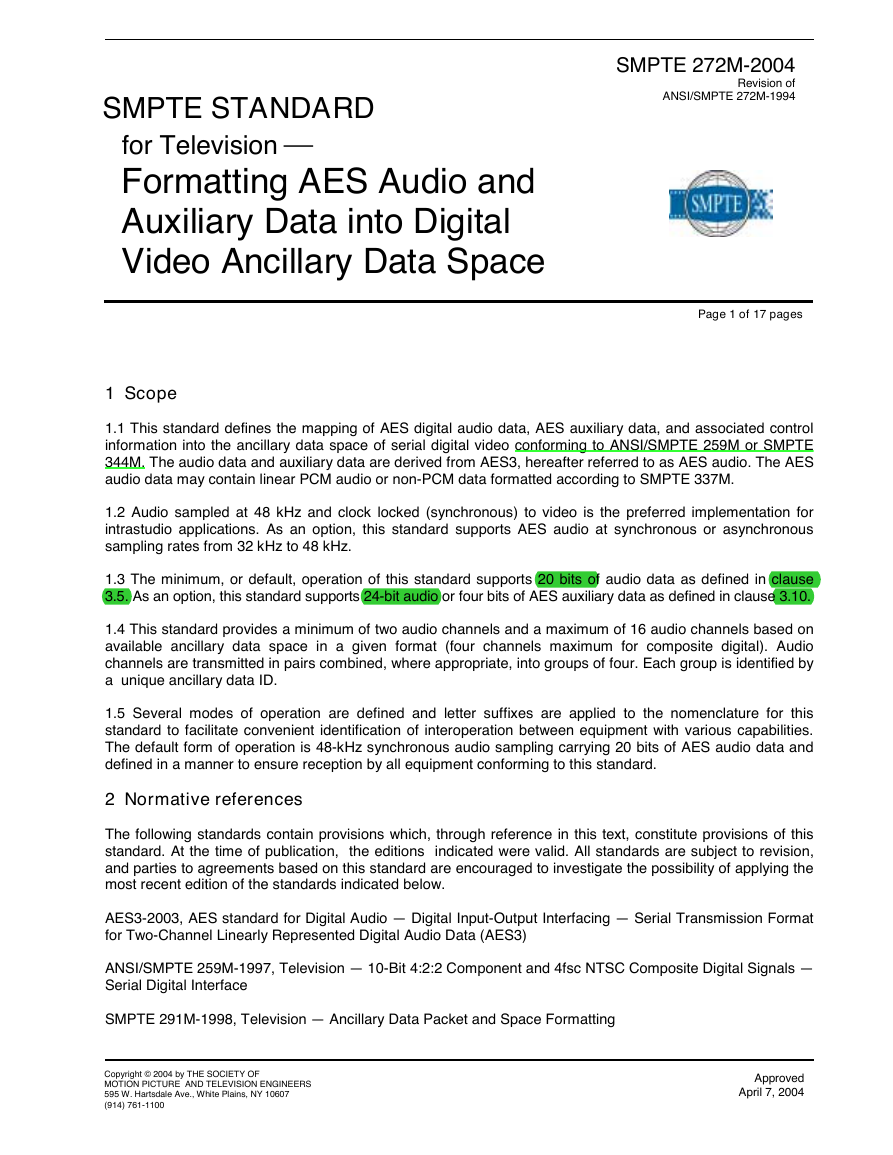
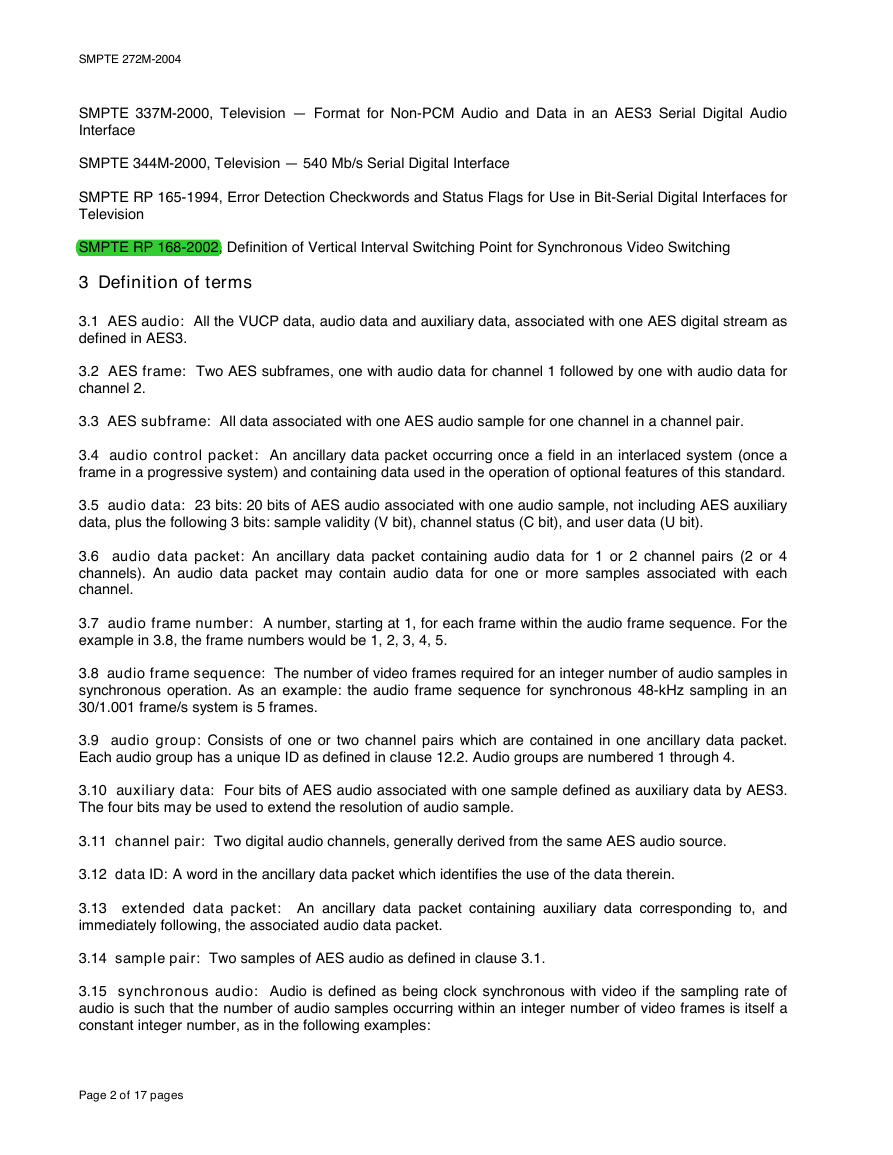
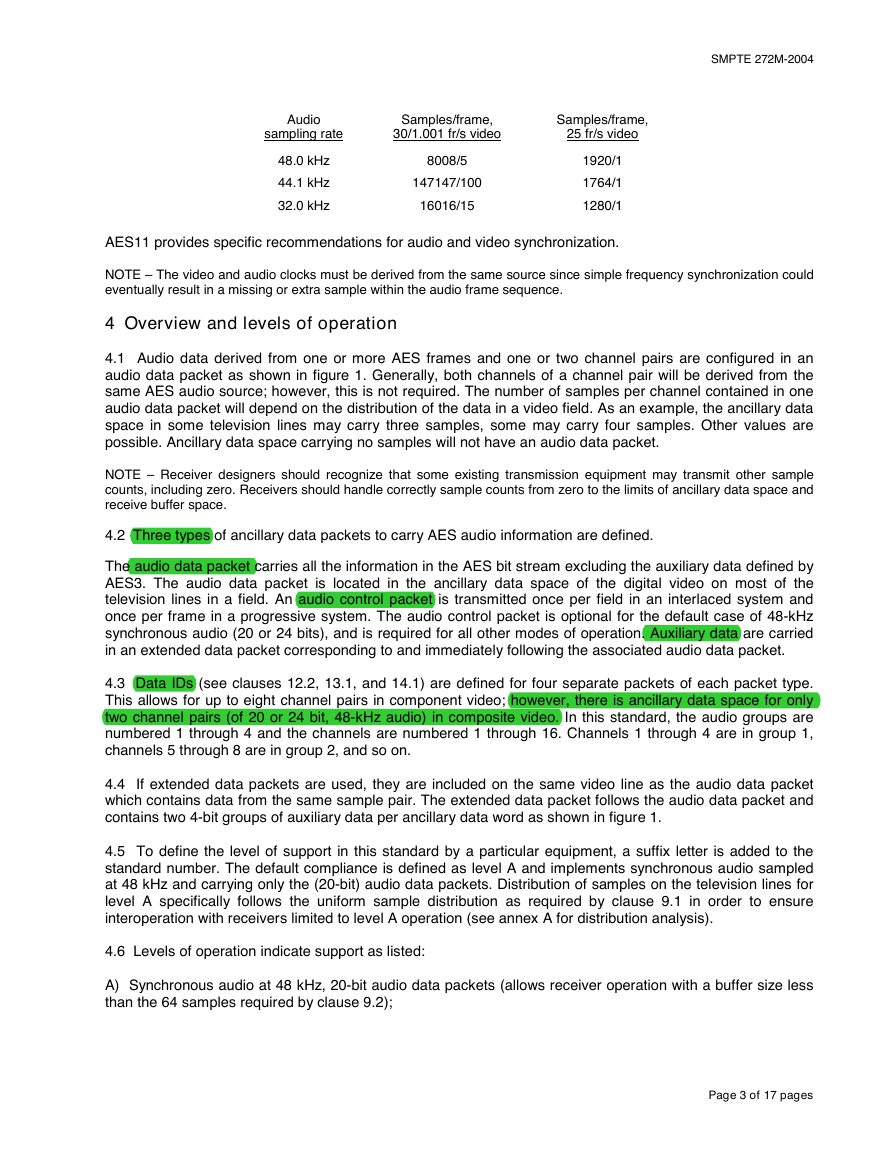
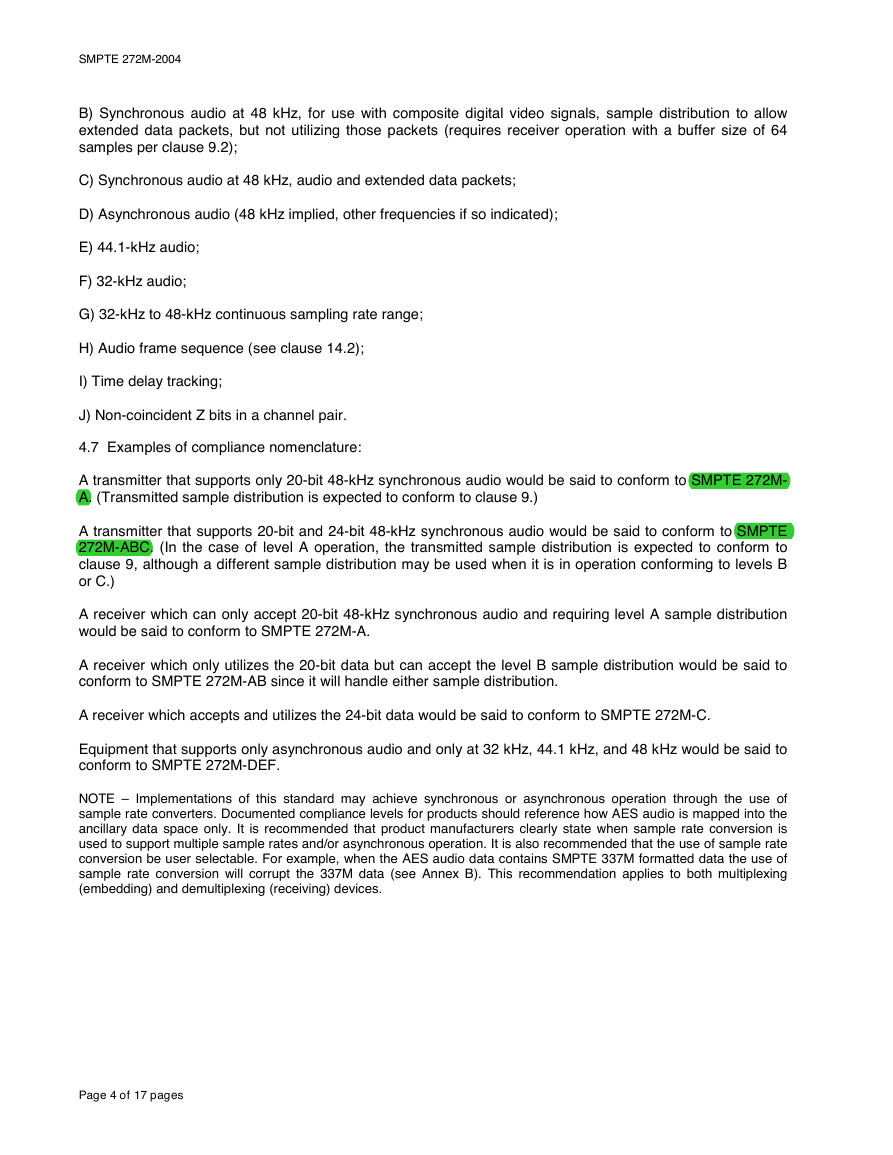

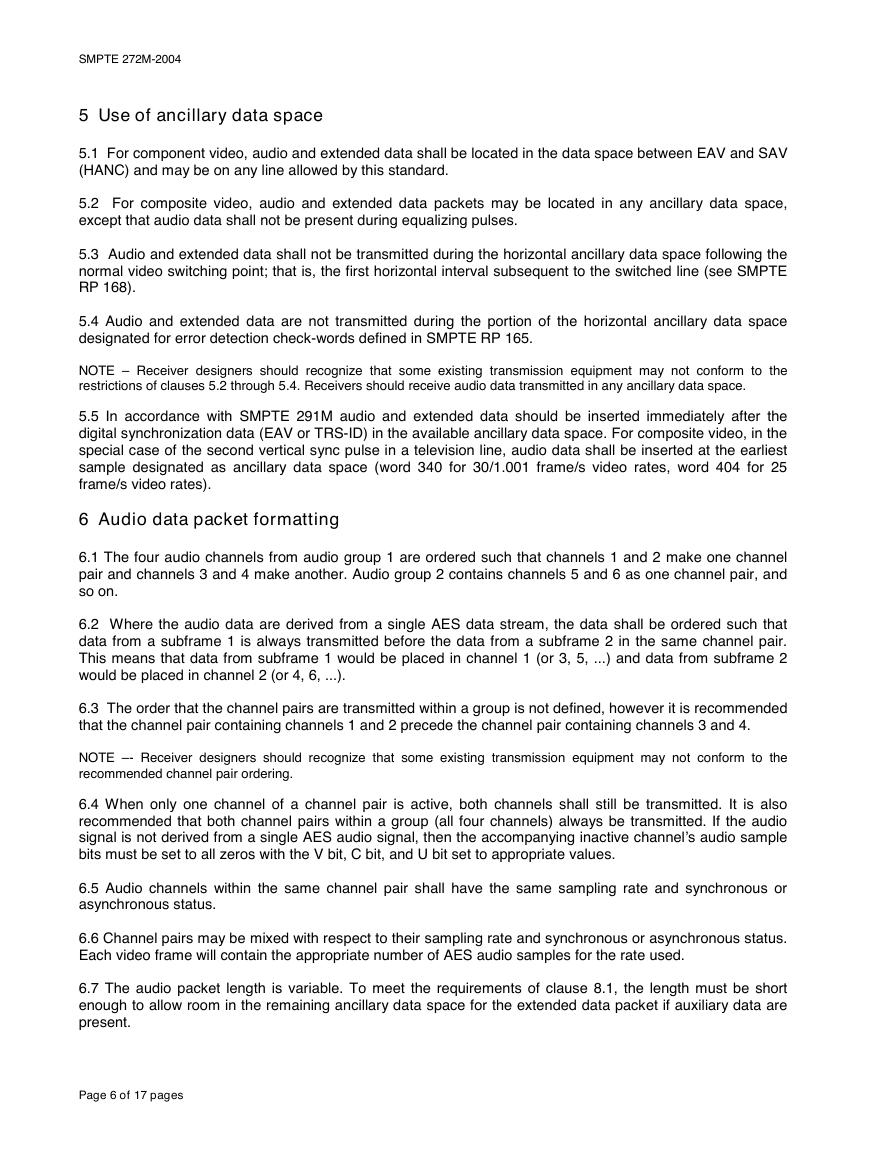
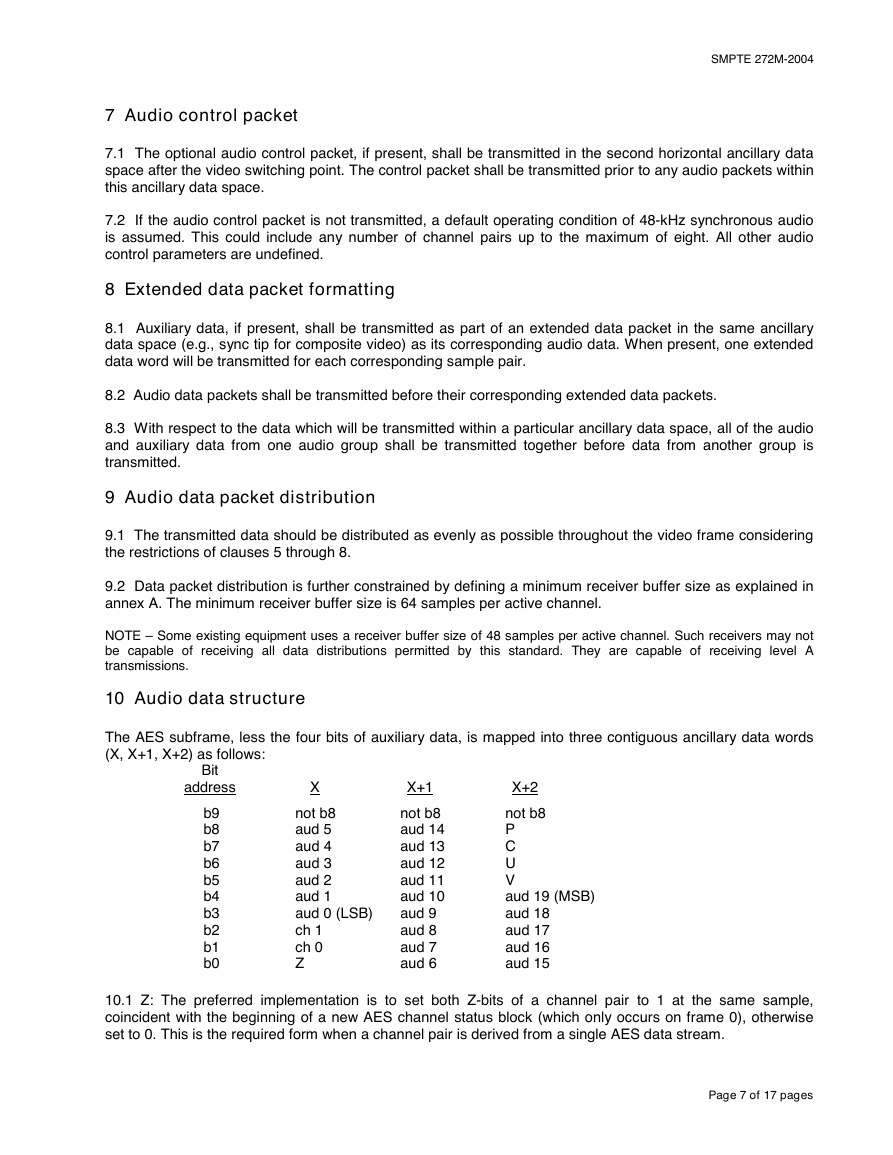









 2023年江西萍乡中考道德与法治真题及答案.doc
2023年江西萍乡中考道德与法治真题及答案.doc 2012年重庆南川中考生物真题及答案.doc
2012年重庆南川中考生物真题及答案.doc 2013年江西师范大学地理学综合及文艺理论基础考研真题.doc
2013年江西师范大学地理学综合及文艺理论基础考研真题.doc 2020年四川甘孜小升初语文真题及答案I卷.doc
2020年四川甘孜小升初语文真题及答案I卷.doc 2020年注册岩土工程师专业基础考试真题及答案.doc
2020年注册岩土工程师专业基础考试真题及答案.doc 2023-2024学年福建省厦门市九年级上学期数学月考试题及答案.doc
2023-2024学年福建省厦门市九年级上学期数学月考试题及答案.doc 2021-2022学年辽宁省沈阳市大东区九年级上学期语文期末试题及答案.doc
2021-2022学年辽宁省沈阳市大东区九年级上学期语文期末试题及答案.doc 2022-2023学年北京东城区初三第一学期物理期末试卷及答案.doc
2022-2023学年北京东城区初三第一学期物理期末试卷及答案.doc 2018上半年江西教师资格初中地理学科知识与教学能力真题及答案.doc
2018上半年江西教师资格初中地理学科知识与教学能力真题及答案.doc 2012年河北国家公务员申论考试真题及答案-省级.doc
2012年河北国家公务员申论考试真题及答案-省级.doc 2020-2021学年江苏省扬州市江都区邵樊片九年级上学期数学第一次质量检测试题及答案.doc
2020-2021学年江苏省扬州市江都区邵樊片九年级上学期数学第一次质量检测试题及答案.doc 2022下半年黑龙江教师资格证中学综合素质真题及答案.doc
2022下半年黑龙江教师资格证中学综合素质真题及答案.doc